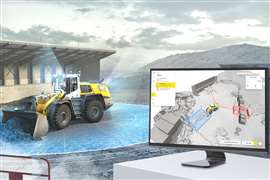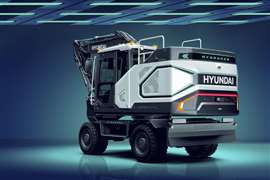Trends shaping construction at World of Concrete 2025
05 February 2025
World of Concrete – an annual exposition held in Las Vegas, US, dedicated to the concrete construction and masonry industries – wrapped its 2025 edition after running 21-23 January.
 A perspective at height of the Las Vegas skyline surrounding the outdoor lots at World of Concrete 2025, which was held at the Las Vegas Convention Center from 21-23 January. (Image: World of Concrete)
A perspective at height of the Las Vegas skyline surrounding the outdoor lots at World of Concrete 2025, which was held at the Las Vegas Convention Center from 21-23 January. (Image: World of Concrete)
Expo officials said this year’s event gathered almost 58,000 registered industry professionals, more than 1,500 exhibiting companies and conducted more than 180 education sessions for contractors and builders.
With so much to see on the floor and conference rooms of the Las Vegas Convention Center throughout the week, there were countless takeaways from what is the globe’s largest concrete-centric expo.
Here’s a look at three keys from World of Concrete (WOC) 2025:
For concrete, the process is part of the product
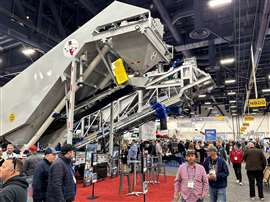 Interior view of the Las Vegas Convention Center during the 2025 edition of the World of Concrete. (Image: Mitchell Keller)
Interior view of the Las Vegas Convention Center during the 2025 edition of the World of Concrete. (Image: Mitchell Keller)
A palpable feeling every year at World of Concrete is just how much this “age-old” industry is advancing. On the exposition floor, one is surrounded by the newest mobile pumps, batching silos and world-class technology companies all with specialised products for concreting.
This year, the concrete production process – and the countless available strategies – seemed to drive as many conversations on the floor as the material itself.
And, as the industry improves its control over embodied carbon emissions and fine-tunes its creation of environmental product declarations (EPD) through life cycle assessments (LCA), some companies are touting big gains.
California-based Fortera – a materials tech company producing cementitious material – was one such company presenting at WOC.
The firm’s vice president of products, Craig Hargis, told Construction Briefing, “The way we do that is through our ReCarb process.”
Hargis said Fortera’s production procedure relies on limestone quarries for feedstock but can also use waste sources of calcium.
“The first step of that is going to be to calcine the limestone and create lime,” he added. “That’s just traditional lime production processes.
“The next thing in our process, the re-carb process, is going to be the dissolution of that lime. So, we dissolve all the lime into our process solution, so that whenever we take it to the CO2 absorber – and we recapture the carbon dioxide – we can then precipitate it in a reactive form of calcium carbonate.
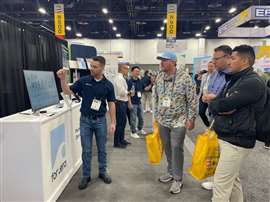 The Fortera booth a World of Concrete 2025. (Image: Fortera)
The Fortera booth a World of Concrete 2025. (Image: Fortera)
“And that’s what’s really different about our calcium carbonates [compared to] just limestone; we have activated them and made them reactive,” Hargis said, noting that’s where the product name (ReAct) was born.
In finished form, ReAct is a reactive calcium carbonate polymorph, known as vaterite, which can be blended into ASTM C150, C595, or C1157 cements or mixed into concrete during batching. The company said – when compared to projects using traditional Portland cement – that up to 70% of embodied CO2 emissions can be eliminated. The company’s chief manufacturing officer, Keith Krugh, said he believed the company’s high-performance brand (ReAct Pure) can achieve zero and negative embodied CO2 emissions.
And Hargis noted there’s still gains to be made.
“Our only CO2 footprint is going to be from the fuel to drive the thermal processes like the lime calcination and the drying,” he said, noting the existing natural-gas-powered method requires less heat than a Portland cement plant (450-degrees Celsius less). “But, also, the electricity to run the pumps.
“So, we have no chemical emission of CO2, we totally recapture that. And that’s what allows us to achieve about two-thirds lower carbon footprint than Portland cement.
“The beauty of that though, is that’s off today’s technology, right?
“Once you electrify this process, you have a net zero cement.”
Concrete remains necessary (and will for a long, long time)
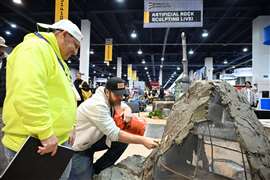 Live demonstration of faux-rock sculpting at World of Concrete. (Image: World of Concrete)
Live demonstration of faux-rock sculpting at World of Concrete. (Image: World of Concrete)
A common theme among all those represented was the immense need for concrete – not just in construction – but for society as a whole.
The American Concrete Pavement Association (ACPA), for example, delivered its assessment of US infrastructure at a WOC press conference, including a look ahead at what is needed.
ACPA – which is the world’s largest concrete trade organisation for concrete pavers – said, even though public investment from the US Infrastructure Investment and Jobs Act (IIJA) was instrumental in amplifying activity in recent years, there remain considerable needs for concrete across the country.
“Factors including inflation, project backlog, and DOT [departments of transportation] turnover caused IIJA and Inflation Reduction Act (IRA) funding to not stretch as far as the industry anticipated, [which] leaves certain key needs and goals unmet,” ACPA said.
It pointed to another trade organisation – the American Society of Civil Engineers (ASCE) – and its quadrennial report on US infrastructure to illustrate how some regions are barely maintaining average quality of public assets. Early grades from ASCE (it will release its full report on 25 March) have individual states receiving “C” and “C-” scores (of note: grades are determined by analysing multiple segments, including ones historically unrelated to concrete work).
Still, the ACPA said, “This means it is critical for state highway agencies to prioritise better utilisation of resources as they continue to pursue their goals.”
And the same can be said in the vertical built environment, where concrete foundation pours, and erection of new concrete structures, should at least maintain its current level of activity.
Dave Jackson, a senior brand manager for Oldcastle APG (including brands Sakrete and Amerimix), told Construction Briefing that the industry is seeing an increase in repair and rehab work, which could amplify the need for concrete.
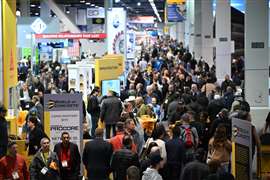 (Image: World of Concrete)
(Image: World of Concrete)
“A focus on repair is a big deal, and I think we’re seeing that a lot in the industry, overall,” he said at WOC.
He also noted, especially in coastal or dry regions, concrete and masonry is becoming more popular (again) as a principal product in home and residential building.
“We bang on the drum of masonry, constantly,” he said, noting the wildfires around Los Angeles, California. “The houses that survived were built with masonry and concrete.
“I think there is continued pressure where builders want to build as cheap as possible,” he continued. “We need to stop building stick houses that are built to last only 15-20 years.”
Balancing concrete’s high CO2 output with the prospect of building more durable and maintainable structures and infrastructure appears to be the industry’s ongoing quest, and one that will surely evolve over the coming years and decades.
New products, sustainably drive innovation
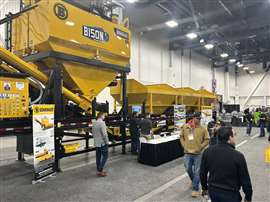 A Böhringer B120 mobile concrete batch plant on the expo floor at World of Concrete. (Image: Mitchell Keller)
A Böhringer B120 mobile concrete batch plant on the expo floor at World of Concrete. (Image: Mitchell Keller)
But Jackson wasn’t hiding from any of the harsh realities tied to the concrete industry, specifically the CO2 emissions created by cement.
“We know it’s dirty,” Jackson said point blank. “It’s 7-8% of the world’s CO2 emissions.”
It’s the type of transparency now abundant in the industry; concrete, cement, and aggregate manufacturers at World of Concrete were in unison on creating new sustainable products and not shying away from the negative statistics of the industry’s past and present.
Jackson said a move toward use of more Type 1L cement (Portland Limestone Cement) has been successful in curbing, foundations, paving and in some precast products while reducing CO2 emissions by about 10%. It’s by no means on the high-end of the emissions reduction spectrum, but it’s a good base-level for a commonly used product.
He noted experimentation with different recycled additives like plastic, biologicals, and glass/pozzolan are showing even further carbon reductions, while also maintaining strength and performance.
While it may appear to be baby steps from the outside looking in, Jackson said the industry is making huge moves and delivering on more sustainable projects that are meeting strength standards.
Pricing and construction’s familiarity with traditional cement-based concrete, in Jackson’s view, are part of what’s holding back a commercial-level switch to more sustainable alternatives.
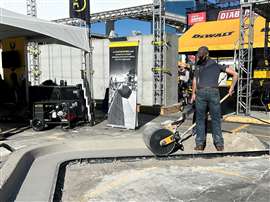 A curb rollling machine exhibit at a WOC outdoor lot. (Image: Mitchell Keller)
A curb rollling machine exhibit at a WOC outdoor lot. (Image: Mitchell Keller)
“The main ethos of what we’re trying to do is reteach people about concrete. There are a lot of products that are more efficient, provide faster time, labour savings, and a better end product, but they’re not going to make those material selections if they don’t feel confident in their knowledge of it,” he said.
Jackson said, with a more expansive knowledge of concrete products available, contractors and builders should feel more comfortable charging appropriate prices based on the product used, while also feeling self-confident in their ability to pour and lay it.
“It’s just giving folks the license to say, ‘I can charge more, because people will pay more because the product is better,’” Jackson added.
ACPA expressed a similar sentiment: “Concrete pavement offers economic sustainability along with environmental sustainability, longevity, and resilience.
“In 2025, the ACPA will continue to advocate at all levels of government for continued funding, support state highway agencies in collaborative efforts to effectively use that funding and leverage the association’s strong industry partnerships to build out the science of concrete pavement’s sustainability including the economic, environmental, and social benefits.”
CONNECT WITH THE TEAM






